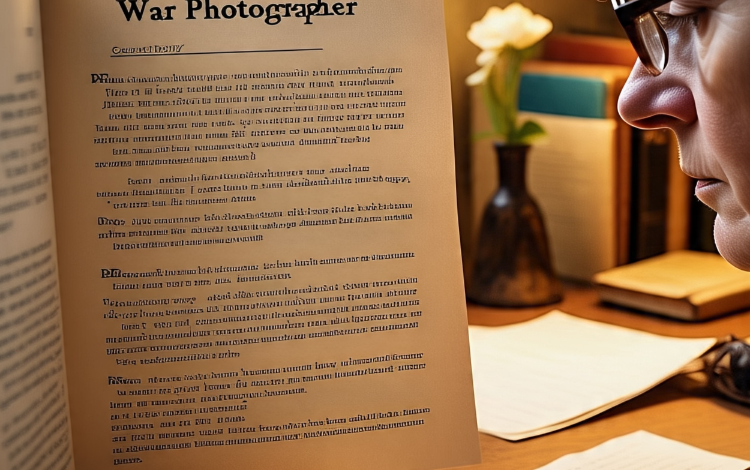
War photographer analysis is a way to look deeply at the poem “War Photographer” by Carol Ann Duffy. In this blog post, we will explain what the poem means, why it is important, and how it makes us feel. This is for students, teachers, or anyone who wants to understand the poem in easy and clear words. Don’t worry if you’re new to poetry — we’ll go step by step and use very simple language.
The poem talks about a man who takes pictures in war zones. He brings the photos back home and works in a quiet, dark room. He remembers all the pain and sadness he saw while taking those pictures. The poem shows how hard it is for him to live with those memories. It also makes us think about how people far away from war don’t always care much about what’s really happening. This is a deep and sad poem, but we will break it down so it’s easy to understand. We’ll look at the words, the feelings, and the messages hidden in each part. Keep reading to learn more about this strong and thoughtful poem.
Table of Contents
What Is the War Photographer Poem Really About?
The poem “War Photographer” is about a man who takes pictures in places where there is war. He sees sad and scary things while taking those photos. After that, he goes back home and works in a dark room to develop the pictures. While doing his job, he remembers all the pain, crying, and danger he saw. The poem shows that he feels very alone and upset. Even though he is far away from the war now, the memories stay in his mind. He tries to help people see the truth through his pictures. But many people don’t care because the war is not happening where they live. This poem tells us that war is very hard, and people who report on it also feel sad. It is not just about pictures — it’s about real life, real pain, and people who are hurting.
War Photographer Analysis: A Simple Line-by-Line Breakdown
The poem starts with the photographer in a dark room. It is very quiet, and he is thinking about the people he saw in the war. The lines show how he works carefully, like a priest doing something holy. Then the poem talks about the places where he took the photos — places full of pain and blood. Each line helps us see the difference between the war zone and his peaceful home. One line says, “A hundred agonies in black-and-white,” which means the pictures show many sad stories. The last lines talk about how people look at the pictures in newspapers but quickly forget. The photographer feels sad that people don’t care enough. Each line gives us feelings — sadness, anger, and a little hope. This line-by-line reading helps us feel what the photographer feels and shows how powerful the poem really is.
Exploring the Feelings in War Photographer
This poem is full of strong feelings. The photographer feels scared when he is near war. He feels sad for the people he sees hurt. When he comes home, he is still carrying all these heavy feelings inside. The poem makes us feel how lonely he is, even when he is back in a safe place. He wants people to understand the pain he saw. But many people don’t listen or care. This makes him feel angry and helpless. The poem also makes the reader feel something too — we might feel sorry for the people in war, or even guilty for not doing more. Carol Ann Duffy, the poet, uses feelings to make the poem powerful. She wants us to see that war hurts not just the fighters, but also the ones who tell the story. The feelings in this poem are deep, strong, and real.
Why War Photographer Still Matters Today
This poem is still very important today because war is still happening in many places. Every day, we see pictures of war on TV and the internet. But like in the poem, people look at them for a short time and then forget. The poem reminds us that behind every photo is a real person with a real story. It helps us think about how lucky we are to be safe. The poem also shows that taking war photos is not just a job — it’s a hard and painful task. The photographer feels all the pain, even after coming home. Today, many photojournalists go through the same thing. This poem teaches us to care more and look deeper. It shows us that the world needs people who tell the truth, even when it hurts. That’s why “War Photographer” still matters so much today.
War Photographer Analysis: Meaning Behind the Photos
The photos in this poem are more than just pictures. They are full of pain and stories that need to be told. Each photo shows a moment from a war — maybe a hurt child, a broken home, or a crying mother. The photographer wants the world to see what is really happening. He hopes the photos will make people feel something and care more. But many times, people only look for a second and move on. This makes the photographer very sad. He wonders if what he does really makes a change. The meaning behind the photos is not just to show the truth, but to make people stop and think. The poet uses this idea to tell us that we should not ignore the pain of others. These photos hold heavy truths, and this poem helps us see that.
Carol Ann Duffy’s Message in War Photographer
Carol Ann Duffy is the poet who wrote “War Photographer.” She wrote it to show the sadness and struggle that war brings. But more than that, she wanted us to see how people who take photos of war feel. She tells us that it’s not easy to see pain and death all the time. The message in this poem is that we should not forget the people in war zones. Duffy wants us to care more, feel more, and not turn away when we see something hard. She uses simple but powerful words to help us feel the same as the photographer. Her message is strong — we all have a part to play in understanding the truth. She also wants us to respect the people who risk their lives to show the world what is happening. That is what makes this poem special.
How the Poet Uses Words to Show Pain and War
Carol Ann Duffy chooses her words very carefully. She uses words like “blood,” “pain,” and “agonies” to make us feel the hurt. She also uses quiet and soft words when the photographer is in his dark room. This shows the difference between the loud, scary war and the quiet thinking time after. Some of her words are strong and shocking — they make us stop and think. She also uses images, like “a hundred agonies in black-and-white,” to show how sad the pictures are. These words make us imagine what the photographer saw. Duffy doesn’t use hard words, but every word has meaning. Her way of writing helps the reader feel like they are right there. The pain, the sadness, the quiet — all of it is shown through her smart word choices. That’s how the poet helps us feel the truth of war.
War Photographer Analysis: Themes of War and Memory
One big theme in this poem is war. The poem talks about places full of danger, fear, and sadness. The photographer goes to these places and sees terrible things. Another theme is memory. Even when he comes home, the photographer can’t forget what he saw. The memories stay with him, and they hurt. The poem shows how hard it is to carry those memories. There is also a theme of people not caring. The photographer shows the truth, but people only look for a moment and forget. This makes him feel alone. The poem also talks about truth and how hard it is to tell. All these themes are mixed together to make a deep and strong poem. When we read it, we understand more about war and what it does to people — even those who are not fighting.
The Power of Images in War Photographer
Pictures can be very strong. In the poem, the photos are not just paper — they are full of truth. Each photo the photographer takes shows a real story, a real person, and real pain. He hopes these pictures will wake people up. He wants the images to make people care and help stop the war. But many people just look quickly and forget. That makes the photographer feel sad. The poet wants us to see that images can change how we think. A picture can show more than words. It can make us feel something right away. That is the power of images in this poem. They are loud even without sound. The poet shows us that sometimes one picture can say more than a whole book. And that is why these photos, and this poem, are so powerful.
War Photographer’s Darkroom: A Place of Reflection
The darkroom in this poem is not just a place to develop pictures. It is also a quiet place where the photographer thinks and feels. In the darkroom, he is far away from war, but the memories are still with him. The red light in the room reminds him of blood and pain. He is alone with his thoughts, and the poem shows us how heavy those thoughts are. The darkroom becomes a safe space, but also a sad space. It is where he faces everything he saw. The poet uses this place to show how the photographer is trying to deal with his feelings. He is not just printing photos — he is thinking deeply. This place helps us understand how hard his job is. The darkroom is a quiet world, but full of loud memories. It is the heart of the poem.
Conclusion
The poem “War Photographer” is deep and full of meaning. It shows us that taking pictures of war is not just a job — it is something that affects the heart and the mind. The photographer feels the pain of others, and the poem helps us feel it too. We learn to understand the truth behind every photo.
Reading and thinking about this poem makes us kinder and more aware. We should not forget the people living in war. And we should thank the ones who show us the truth. This poem reminds us to care more, feel more, and remember what really matters.
FAQs
Q: What is the poem War Photographer about?
A: It is about a man who takes pictures in war zones and feels sad remembering what he saw.
Q: Who wrote War Photographer?
A: The poem was written by Carol Ann Duffy.
Q: Why is the darkroom important in the poem?
A: The darkroom is where the photographer thinks about the sad things he saw.
Q: What is the main feeling in the poem?
A: The poem feels sad, serious, and full of pain.
Q: Why should we study War Photographer?
A: It helps us understand war, feelings, and the truth behind photos.



